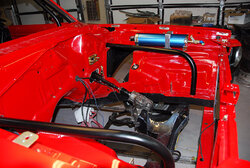2000StreetRod
Moderator Emeritus
- Joined
- May 26, 2009
- Messages
- 10,597
- Reaction score
- 334
- City, State
- Greenville, SC
- Year, Model & Trim Level
- 00 Sport FI, 03 Ltd V8
Engine analysis has revealed that most of the wear occurs when the engine is cranked and started without oil pressure. In the case of the SOHC V6 engine, timing chains are most likely to slip when the spring/hydraulic left front and right rear tensioners have little or no oil pressure. I decided to install a pre-oiler to reduce future engine wear and the chance of timing chain slippage. There are two types of pre-oilers. One type is an electrical pump that draws oil from the bottom of the oil pan and forces it into the engine oil galleries. It requires drilling a hole in the oil pan and running an oil line/hose to the pump. The other type is an oil accumulator that consists of a piston inside a cylinder that stores air pressure on one side and oil pressure on the other.
I decided to incorporate an oil accumulator and selected the 3 quart capacity Accusump by Canton Racing shown in the photo below.

The system consists of the accumulator (piston and cylinder) and a oil control valve. I chose an electric solenoid controlled valve energized by the ignition switch. An additional switch prevents the valve from being open when the ignition is on. This allows retention of the pressurized oil in the accumulator when the ignition is on but there is no intention to start the engine. When I received the accumulator the air pressure gauge reading was 60 psi. This proved that there were no leaks on the air side and that the piston would be fully extended toward the oil side. There is a pressure bleed valve next to the gauge and I used it to reduce the air pressure to the recommended 7 to 10 psi.
There are several types of solenoid valves. I chose the one suitable for pre-oiling but not for racing. It has a rapid discharge capability but a slow fill capability.
I decided to incorporate an oil accumulator and selected the 3 quart capacity Accusump by Canton Racing shown in the photo below.
The system consists of the accumulator (piston and cylinder) and a oil control valve. I chose an electric solenoid controlled valve energized by the ignition switch. An additional switch prevents the valve from being open when the ignition is on. This allows retention of the pressurized oil in the accumulator when the ignition is on but there is no intention to start the engine. When I received the accumulator the air pressure gauge reading was 60 psi. This proved that there were no leaks on the air side and that the piston would be fully extended toward the oil side. There is a pressure bleed valve next to the gauge and I used it to reduce the air pressure to the recommended 7 to 10 psi.
There are several types of solenoid valves. I chose the one suitable for pre-oiling but not for racing. It has a rapid discharge capability but a slow fill capability.













